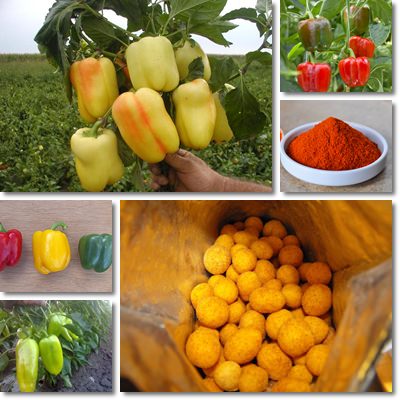Dating back to the late 1800s, paprika is a culinary and cultural relic left behind following the Ottoman rule over major parts of Europe. This spice made from both sweet and hot peppers (Capsicum annuum) is a great source of exquisite flavor with a high nutritional profile. However, peppers and spicy foods in general do not agree well with stomach disorders, so anyone suffering from gastritis, ulcers or acid reflux should avoid them to prevent side effects such as abdominal pain or heartburn.
What is paprika and how is it made?
Paprika is a bright red spice made by either air-drying and grinding peppers or by drying, smoking and grinding peppers into an incredibly fine and savory powder. Both sweet and hot Capsicum annuum peppers are used. Paprika was used extensively during the Ottoman rule and pervaded the culinary culture of most of the countries or regions found for even brief historical moments under the authority of the once great empire.

What does paprika look like?
Well, as mentioned above, paprika is a fine powder ranging in color from bright to deep, dark red, even reddish brown. The variety of peppers used, fruit age at harvest time, choice of fruit parts (e.g. pepper flesh or flesh and seeds), any form of processing undergone such as drying or smoking and more factors all contribute to the color of paprika.
What does paprika taste like?
Paprika flavor ranges from mildly sweet to mildly hot and various other degrees of unbearable spiciness. The real spice should be quite flavorful, especially if smoked. The difference between sweet and spicy paprika is that in the making of sweet paprika, sweeter pepper varieties are used, but usually without adding too many seeds. Hot paprika contains the entire pepper, skin and pulp and seeds. What is paprika good for?

Paprika benefits for health
Here is a list of the top 8 nutrition facts and health benefits of paprika:
Rich source of vitamin B6
Paprika is a rich source of vitamin B6, or pyridoxine. Vitamin B6 increases the amount of oxygen transported to cells in tissues and organs, especially during more intense physical activity, resulting in better resistance to physical effort. Moreover, it helps break down carbohydrates and synthesize glycogen, thus ensuring good energy levels. A good intake of vitamin B6 can efficiently prevent tiredness, lethargy and even depression episodes.
Reduces inflammation, swelling and pain
Paprika boasts excellent anti-inflammatory properties which is why it helps relieve swelling and pain associated with inflammatory and even autoimmune disorders. For instance, arthritis sufferers often use paprika both internally (as food seasoning) and externally (massage cream or poultice) to stimulate circulation and reduce painful swelling. The biologically active component responsible for these health benefits in paprika is capsaicin.
Impressive blood pressure-lowering effects
Capsaicin is a powerful natural compound found in paprika which was shown to have blood pressure lowering effects. Regular but moderate consumption is said to beneficially affect the circulatory system, relaxing blood vessels.
Helps protect vision and improve eyesight
The bright red color of paprika indicates the presence of potent natural compounds called carotenoids. Studies show that paprika is an incredibly rich source of zeaxanthin, a carotenoid with both antioxidant and vitamin A activity. Zeaxanthin is physically found in the center of the retina, in an area called the macula lutea and regular consumption of foods containing it, paprika especially, is believed to offer protection against cataract and macular degeneration (loss of central vision). Basically, zeaxanthin offers antioxidant protection and support to cone cells, a form of eye cells responsible for sharp, clear vision and color distinction. Paprika also contains great amounts of vitamin A proper and lutein.
Acts as a digestive aid
Apparently, eating paprika stimulates the production of saliva and gastric acid, two essential components of good digestion. Both saliva and gastric acid help break down food in view of good nutrient absorption and energy production. However, the spice is not recommended for gastritis or acid reflux sufferers because it may worsen symptoms (see what foods to eat and to avoid for acid reflux).
Laxative properties
Only 100 g of paprika provides us with a staggering 34.9 g of dietary fiber. Since it is not advised to eat great amounts of the ground spice at once, especially if made from hot peppers, regular consumption of fresh bell peppers instead of paprika, for example, can contribute to a better management of constipation by adding fiber to your diet.
Potential benefits for hair loss prevention
Paprika appears to counteract hair loss. The good amounts of iron in paprika help oxygen reach hair follicles, while other compounds stimulate scalp circulation, thus promoting hair and scalp health and reducing hair loss.
Improves sleep quality
As mentioned above, paprika boasts great beneficial effects on the nervous system. One of these is supporting the production of melatonin, also known as the sleep hormone. Melatonin regulates sleep cycles, ensuring quality sleep and improving various sleep disorders.
Types of paprika
The peppery spice is graded according to pungency and may range from:
- Sweet paprika, made from dried and grounded sweet peppers or bell peppers, mostly red varieties.
- Sweet and spicy/piquant paprika, a flavor profile obtained by using both sweet pepper and various amounts of chili peppers or, more rarely, cayenne peppers.
- Hot paprika, also called spicy paprika, made from hot chili peppers. The spiciness can vary depending on the varieties of spicy peppers used and ranges from mild spiciness to extreme pungency. It should be noted that the spiciest paprika is actually brown in color, not red like most other types. Also, hot paprika types may contain both the pepper flesh and other parts, especially the seeds which are known to also be extremely spicy in most hot peppers.
Smoked vs non-smoked paprika
Most paprika is the non-smoked type, meaning selected pepper varieties are dried (sun-dried, oven dried or dried mechanically) and grounded to make the spice. Smoked paprika is made by drying selected pepper varieties by smoking over wood fires. The aroma of the smoke is absorbed by the peppers and imbues the paprika with a rich flavor with warm, woody notes. Smoked paprika adds depth to any dish and can be used in stews, roasts, especially for heavy pork meat or stronger-flavored game and essentially any food or dish that is rich or heavy. The pepper varieties and type of wood used for the fire and drying and smoking of the peppers as well as the degree of smoking will determine the particular flavor profile of the paprika.
From a nutritional point of view, smoked foods are not healthy in the long run because the rich smoky flavor is caused by potential and known carcinogenic by-products. If consumed regularly over the course of years and in significant amounts, smoked foods can increase the risk for various cancers like colon cancer. However, if consumed infrequently and in limited amounts, there may be no significant increase in cancer risks over time, or so the experts say.
Paprika side effects
Side effects of paprika, namely gastrointestinal upset, may occur with singular use. Chili peppers or hot peppers, used to make spicy paprika, contain capsaicin which, while healthy, can also act as an irritant to mucous membranes and produce gastrointestinal upset. Sweet peppers or bell peppers, used to make sweet paprika, contain capsinoids, capsaicin-related compounds that lack the pungency but which still produce gastrointestinal upset. So if you are feeling sick to the stomach or develop heartburn or hemorrhoids upset you after eating spicy or sweet paprika, then the capsaicin might be the cause or the related capsinoid compounds.
Also see what are the main 7 side effects of hot chili peppers.
Conclusion
Overall, paprika is a healthy spice with a variety of amazing health benefits, provided it is consumed with moderation. I admit it ranks high among my favorite spices and I kind of prefer sweet paprika over hot paprika, as my gastritis and acid reflux problems do not allow me to indulge in any type of spicy food. Nevertheless, it’s important to note that not everyone has the same tolerance to spicy or sweet peppers so if you experience gastrointestinal or other side effects more than once after eating paprika, it might be wise to consider switching to other spices. How often do you use paprika and which do you prefer: sweet or spicy?
